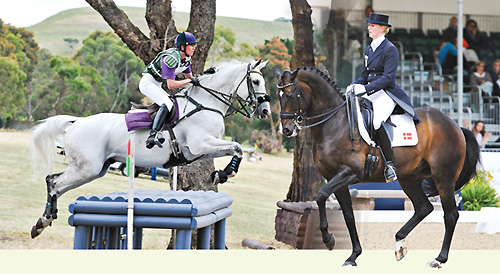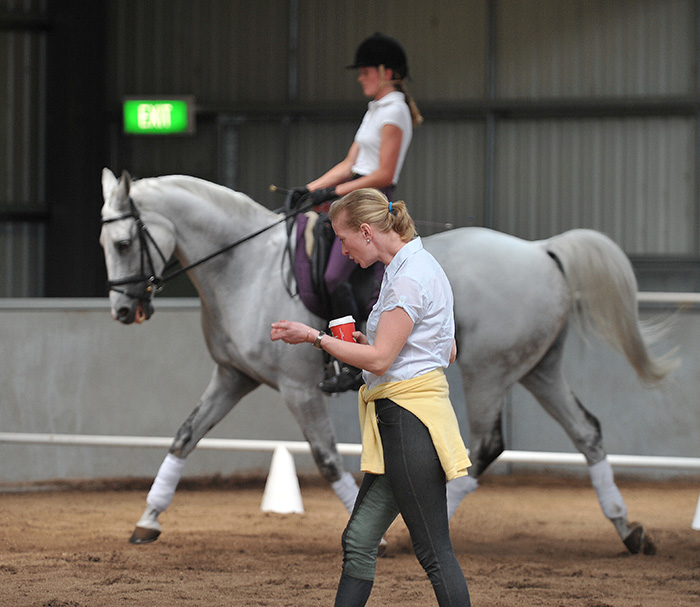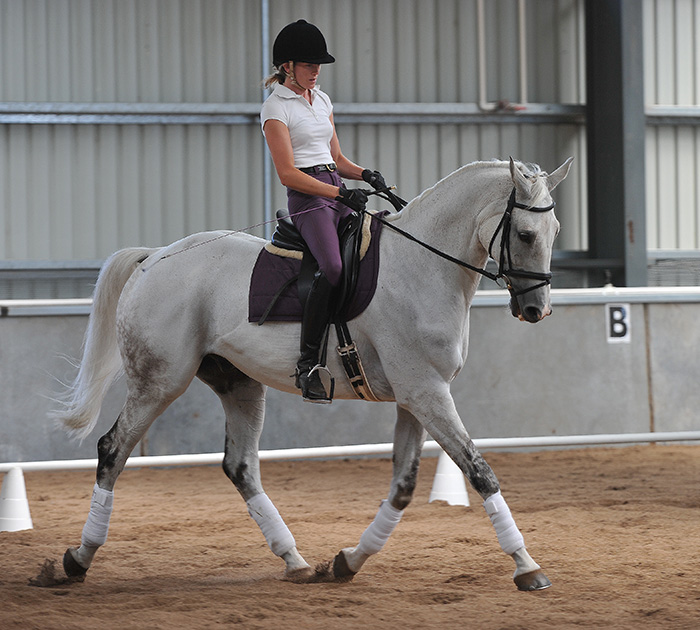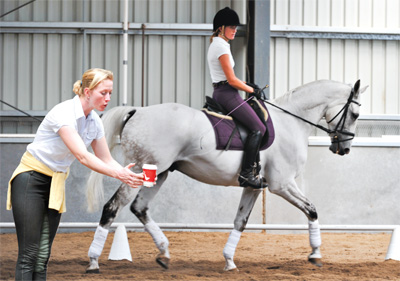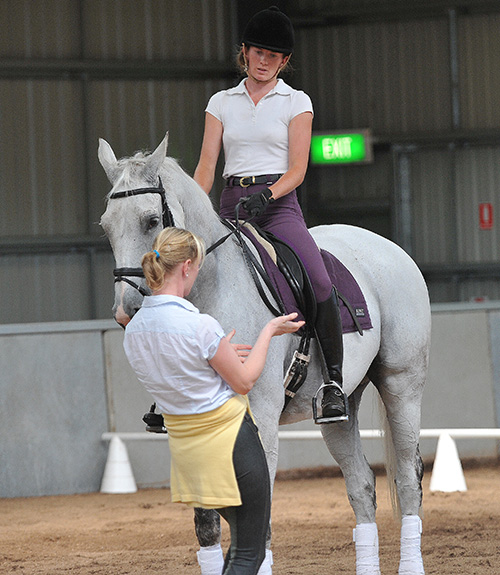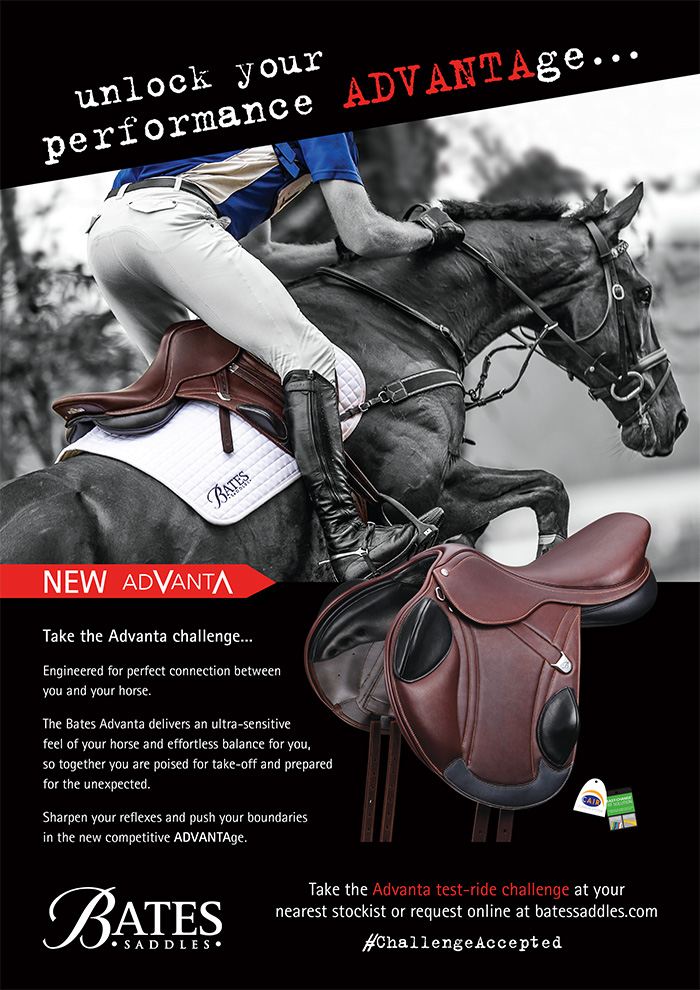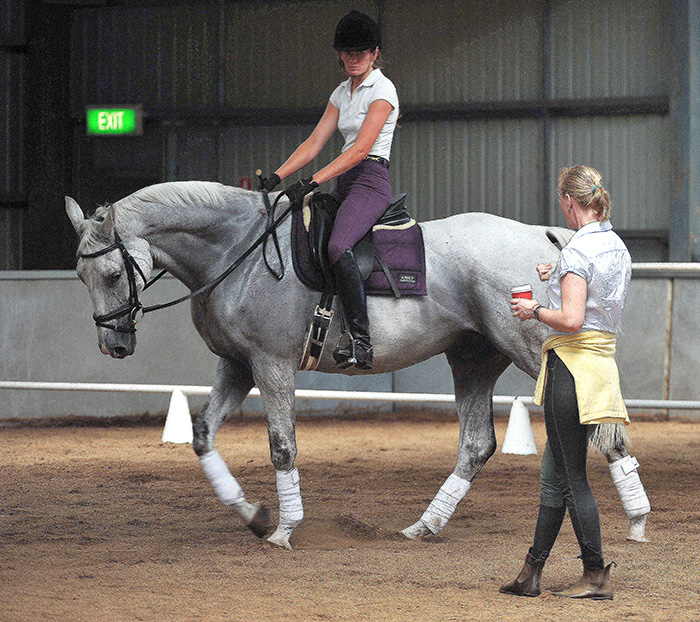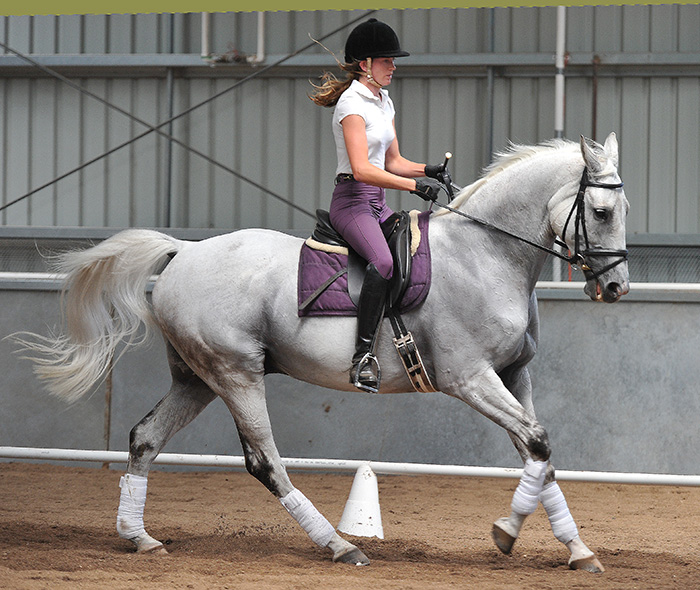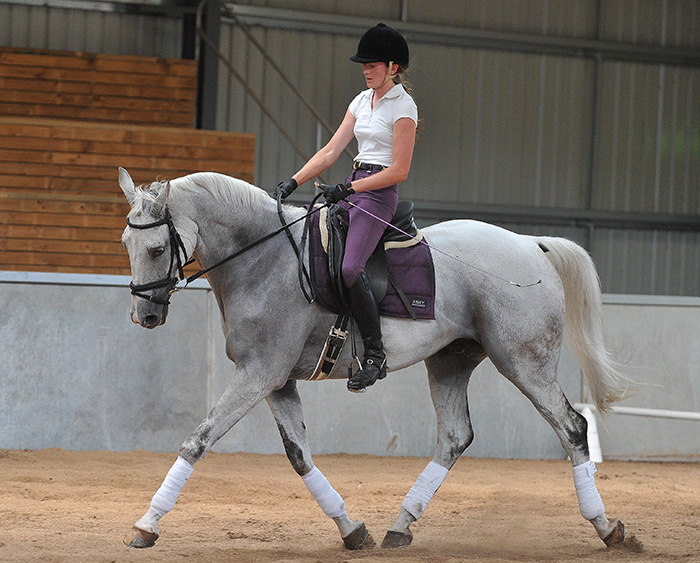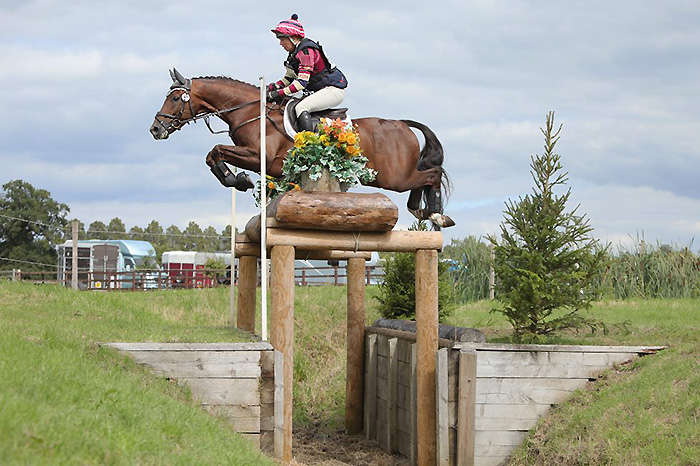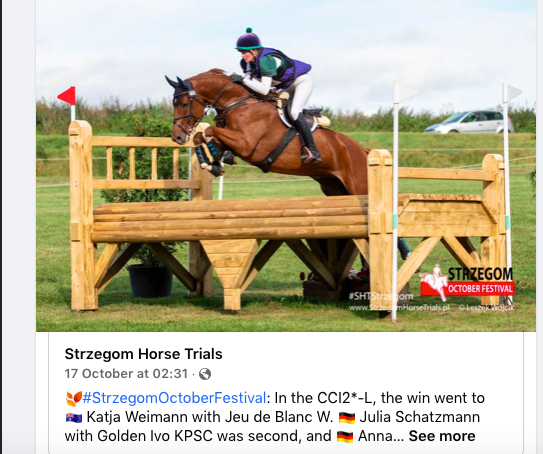
This facebook entry reminded us of one of our very favourite explanations of THE BASICS – we hope you enjoy this lesson with Princess Nathalie and Katja…
Danish dressage star, and now trainer of the Danish team, Princess Nathalie, works with an event rider in Australia some years ago. The rider was Katja Weimann on her then two-star ride, Pluto Mio. Katja is currently based in Europe and has had a recent win, and Pluto went on to represent Australia with Stuart Tinney at the WEG at Normandy in 2014, and at the Rio Games in 2016.
Nathalie working with Katja on the basics – essential reading for all riders:
“Event riders are quite different, it’s a nice challenge to have to work with your brain to think how you can make it work with that type of horse. An event horse is very different from a dressage horse, in the way the muscles are developed – because it has to jump and go across country. They are different muscles to a real, proper dressage horse, so that makes the conformation and the balance of the horse, slightly different to the dressage horses. The riding should still be exactly the same. Katja just needs to get her body a bit more into ‘I want this happening, here and now’. The rider’s body language is very important. If you want to make a half halt, and you tell the horse by your body language, okay we can do it when you feel like it, that’s a problem. But if you tell the horse with your body language, I want the transition here and now, you have it in your body and you can tell the horse, hey, you come back and you listen.”
To the surprise of some at the clinic, the eventing rider looked very stylish in the dressage arena, and proved to be a very receptive pupil. It is a curious paradox that it is harder to teach ‘the basics’ than ‘the tricks’. Working on honestly establishing a harmonious and effective relationship between horse and rider, requires a rider with a secure and effective seat and a horse that has been honestly started. I’ve lost count of the number of times I have seen gifted visiting instructors throw their hands in the air as they realize that no matter how often they repeat themselves, the rider in front of them is not going to ‘get it’ and suggest that perhaps we practice changes, or passage or pirouettes, anything that disguises the fact that the all important first step has not, and will never, be achieved…
It is wonderful to see the lesson unfold…
And what are they working on? Walk / trot / walk transitions on a twenty metre circle. Transition, after transition, after transition. And was it boring? Not a bit of it, it was fascinating.
First Nathalie was concerned to get Pluto more active behind, this she saw as the key to getting him lighter and more through:
“Get him quicker behind and then make a half halt on the outside rein. Feel when you make the half halt that his hind legs are still stepping under. You have to think a slightly quicker rhythm than he is giving you – more activity. Ask for the hind legs to be more active all the time.”
After the lesson Katja was thinking hard:
“Obviously I’m not quick enough, or strong enough, to keep the hind legs forward. He’s got that big nice stride and you can get tricked into thinking, oh that’s good, but it has got to be that little bit quicker, and if you keep it quicker then it is a little easier to keep him up, but all along that has been his problem. He just halts on his front legs, that’s been my main trouble, keeping him up, through and forward.”
The idea was to be able to make the horse longer, looser, without losing that increased activity: “When you feel he is pushing forward, give some rein but keep riding the hind legs. When you give, be careful he doesn’t go dead on you, give but still go forward.”
And you could really see the horse getting longer and so much looser…
“When you close your leg, you want to feel him moving his leg out of your way. Keep your leg on the girth, so you feel when you come with your leg, you move his shoulder out of the way first. Close your leg, and wait until you feel his leg goes up, then relax, that is his reward.”
So we started on the walk transitions, and you could see, that every time Katja asked for a downward transition, the horse said, okay, but you have to throw everything away, and let me do it on my terms, let me drop on my forehand and lose the forward. Not in Nathalie’s lesson he wasn’t…
“He has to stay engaged in the walk transition, push your tummy muscles into your hands and get strong in your position. If he goes against you, use your knee and tummy and the reins and create a triangle that is really strong.”
“When you go to walk, move the bit around a little in his mouth, don’t give him the chance to grab. You don’t need people to see what you are doing, just vibrate the bit a little. If he is not responsive, come once really hard with the hand, but next time, very soft. Sooner or later they learn, but first you have to tell them you really mean it. You ask for the walk transition and he goes slightly through your hands – hey! I really meant walk. Get strong. If you let them get away with it, it get’s worse, he has to think ‘oh she really means it’. You have to think of the more correct transition, and if he doesn’t give it to you, tell him.”
Later I pointed out to Kaja that it was kind of ironic with a dressage rider preaching to an eventer this message of tough love, but you could see it working, see the outline changing, the suppleness coming into the body.
“That’s it,” Katja agreed, “he has got to go NOW, there is no other option, it has to be now, He was heaps better, a couple of times he did get that kick and the next time I asked, he just went forward. He’s pretty good like that, when you are teaching him something, he doesn’t get silly and blow up. He thinks about it, and he’s like, okay I’ll try this. When he goes against you, I think it is because he doesn’t understand what I am asking.”
For a long time, eventing riders gave themselves this easy out, oh our horses are really fit, so you can really expect them to be disciplined and do dressage… your horse is pretty fit, he just did Adelaide and Camperdown…
“That’s it. The fitter you get him, he doesn’t get hotter. I suppose it depends on the type of horse, but I think if the basic training is there, you have the basics working, it is easy to keep them from getting hot. I’ve got my chestnut horse, and he gets really hot, but he doesn’t have the basics, he’s not really through from behind, so he does get a little hot and tense in his test when he is really fit. I think when they get ‘hot’ it is that they are anxious and tense, then if the rider gets mad at them, it’s like, I’m not going to do anything.”
more follows
But it is not cruel or horse abusive to give them a good kick in the ribs to make your point…
“Ask nicely, and if it doesn’t happen, go again a bit harder – it worked in that lesson, he got better. It’s not being harsh, it is making it clear to them and then they understand. Confusing them all the time, that is being mean, and nagging at them all the time.”
“He felt good by the end of the lesson, I just have to keep it going because he can really move. He is a lovely horse to ride, it is just a matter of me being disciplined and asking for it right now – being a little stronger in what I want, and what I get.”
Nathalie kept stressing that the way to get the horse nicer in front was by getting him nicer behind…
“The more you get the motor working, the softer he will be in trot. He has to understand that it’s finished with kilos in each hand, you want to sit, and enjoy it. If he gets heavy, push the hindlegs. Try the walk transition again…”
Talking after the lesson, Nathalie identified the problem:
“When she gives the hand forward, he just tries to stop instead of carrying himself around and being active. I am sure that the whole time the rider has the feeling that she has to chase him to make sure he stays active. I think maintaining activity is something you keep working on for the horse’s whole life. You either have a really hot horse who thinks forward the whole time, or you have horses that this is their big major problem and you have to work with it all their lives, to keep them engaged enough and round enough and forward enough – it’s not something with those horses that you can switch on, and it is there. Especially if you give them a little time off, it goes away, and when you put them back into work, you have to refresh it. Some other horses, it is just there by nature.”
And this time it is super, the horse really stepping through, keeping the engagement in the walk.
“That was better, can you feel that? Now trot.”
And this time Nathalie is not happy, the reaction has been too slow:
“You have to think, what reaction do I want when I come with my leg? Be disciplined. When you say ‘trot’, it is right there, or he gets one between the ribs. Keep doing it until you get the reaction you want. Get angry with him, then sit still again, that’s the reward.”
It was the same message in the canter:
“Feel the hind leg reaching underneath your seat, and if he doesn’t, give him another with your legs, then soft. With horses, it is black and white, if you give your little finger, they will take your whole arm. That’s better, pat him, tell him: this is the amount of rein, and you give in to that. The reins belong to your hands. When you try to get longer, I am going to make you move more from behind until you give in. You have to be disciplined, this is what you want and this is what you get. You say to him, I give my hand but only until there – then you give in. Kyra (Kyrklund) always says, in everything you do with the horse, you have to think quick, you have to want it now.”
And not surprisingly, when it comes to the canter / trot transitions, the horse wants the same compromise he enjoyed in the trot / walk ones, he just wants to fall on his forehand and die in the transition:
“The moment you feel him starting the transition, give the rein forward to go into trot. It’s not that you can teach transitions and then they have it for the rest of their lives – you have to work every day on transitions, and there are some good days, some bad days. You have to work all the time to keep them sensitive to transitions. We dressage riders too, have to ride transitions all the time, it’s not because he is an eventer.”
This time the horse comes from canter to trot, and keeps going forward nicely in the trot:
“Much better huh? It’s what you put into your head. You have to know exactly where you want the transitions, be aware that you are the boss up there.”
“So is there anything you would like to work on?”
“Walk pirouette…”
And once again, we see the problem. Pluto is quite happy to execute a walk pirouette, as long as it is on his terms, and horses being horses, that means with the least amount of effort possible, grounding his hindlegs and quickly ‘spinning’ his front end around.
More tough love:
“Don’t accept him taking over. It’s step forward and turn, use your inside leg, ride him every step, every step under control, he has to accept that he has to use his hind legs.”
I commented after the lesson to Nathalie, how quickly the pirouette improved…
“The horse has to be more responsive to smaller half halts, but also active, so she can keep him more active underneath her seat, so she can tell the front part: stop, stop, stop, but the hindlegs keep on walking, the horse keeps moving instead of falling in on the inside shoulder, with the inside hindleg just going sideways to avoid bending through the ribcage. You get the bending with the inside rein, but you do the half halts with the outside rein – if you overbend them you lose the outside shoulder, it’s more keeping them upright between your hands and legs, so you can take on the inside rein, and half halt out the outside to get every step as you want it to be.”
Really this lesson of precision, of getting every single step right, was the one Katja took home to work on…
“I learned what I have to do to make the horse work. It’s like little things that you have kind of known – like helping me with the walk pirouette there. A lot of people don’t actually tell you how to ride it – it’s like, go and do a walk pirouette. So you do it how you think it should be done, but there are little things, like that little more inside leg as he comes around, having the front legs in front of the hind legs as they come round – just little things. He tends to take over, he goes to do it, and you put him in the right spot – and he says, okay I’ll just do the rest of it on my own. It is a matter of controlling every step, what to do with your hands and legs and everything, she is so good at those fine details.”
In the first lesson he was dying on you when you did your trot to walk transition, and it was exactly the same when you were doing canter to trot transitions. The trot / canter transitions were beautiful, straight, forward, up, instant, but every time it was the downward transition…
“He wants to lean on your hand, he says, you hold me here and I’ll just fall into trot. So I’ve got to sit him more on his hind legs, and keep him coming through to get the trot forward and up. So he wants to go to trot and I say, no a little more, then the transition…”
It is different when you get an instructor who you know is riding every day…
“Someone who knows what it is like to sit on a horse, and knows what it is like to ride a horse that is not always doing what it is told, because quite often, that’s what they do. When you have an instructor who is out there and doing it, they have a better chance of telling you the little things that keep it going properly. That’s what lessons are all about, try what the instructor is saying, and if it works for you, then it works for you – if it doesn’t, it doesn’t. Everything has worked for me in there, I’ll take all that away and see how we can improve him.”
Breeding an event horse? Go to www.ihb.com.au and find the bloodlines you need to breed your champion – stallions like Britannia Royal


